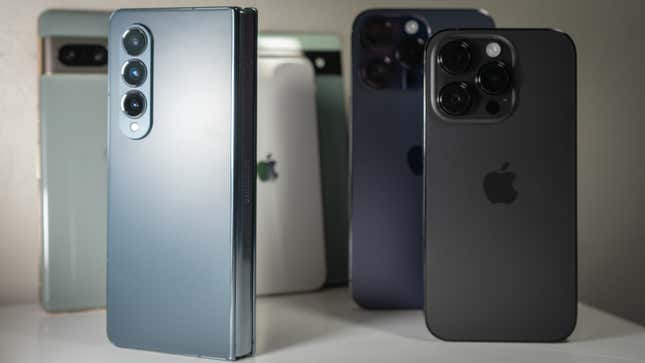
Florence Ion covers smartphones and smart homes for Gizmodo. She’s been writing about the Android operating system since 2012 and recently added iOS to her repertoire. You can follow her coverage here, and email story ideas or arguments about why she should switch to the iPhone here.
The top story:
Android’s market share is trailing behind Apple in the U.S. and Canada, and iPhones recently scored more than 50% of the total US market for the first time ever. It’s probably all about the ecosystem: No one does a walled garden that’s worth sitting in like Apple. Google and Samsung certainly try, but those two companies are also competing with one another, so the platform is segmented. We’ll be watching closely to see how Android fights back in 2023.
What we’re waiting for:
- Samsung’s Galaxy S23 flagship family, which includes the Galaxy S23, S23+, and S23 Ultra, will be the first batch of smartphones to debut in Q1. Their arrival tends to set the trajectory for Android devices for the rest of the year. Will it excite us in 2023? (It didn’t excite me last year.)
- Google and Apple’s developer conferences happen in May and June, respectively. That’s when we’ll find out all the new capabilities coming to Android and iOS. It’s the best indicator for where the respective ecosystems are focused.
- Foldables are gaining traction with more additions from overseas brands like Oppo and Huawei. We’ve now got lots of foldable options, but will they become affordable in 2023?
Unconventional wisdom:
Google is into the habit of dropping special features just for its Pixel smartphones. There’s often a technical reason for the exclusivity; after all, the whole point of the in-house Tensor chip was to fine-tune its AI capabilities so that Google could sell more smartphones. But this practice will lead to more fragmentation in the Android operating system. Even with Google’s unification efforts through the Android source code and providing updates piecemeal through the Play Store, as long as Google, Samsung, and brands like OnePlus do their own thing to compete with one another, the disparity will continue.
People to follow:
- If you’re keeping an eye on what’s new with Android, Mishaal Rahman does some of the most thorough code-sleuthing. You can find his Android source code breakdowns at Esper.io.
- Follow Google’s Dave Kleidermacher, VP of Engineering at Google for security and privacy on the Android platform and other Made by Google products. Kleidermacher offers some insight into what’s going on behind the scenes with Android’s security practices.
- I’m still not sure where to be on Mastodon, but the Android developers leaving Twitter have formed a space to exist.
- Display watchdog Ross Young is an interesting Twitter account. Young has managed to predict what’s happening in the smartphone space based on the display supply chain pipeline. It’s uncertain how long Young will continue to use Twitter to broadcast this information. You can only see it now if you’re a paying subscriber.
- Read Bloomberg’s Power On newsletter to see what’s next with Apple’s iPhone. Author Mark Gurman has been on the mark throughout the last year. The newsletter is also a helpful tracker of what Apple’s working on and where it’s focusing its efforts.
Companies to watch:
- Google: Android’s maker is trying to establish a standalone brand while providing source code to outside competition like Samsung and Motorola. Will it gain any significant market share with the Pixel, or will Android still rely on Samsung to overthrow Apple’s iPhone?
- Apple: Rumors are circulating that Apple may postpone its next iPhone SE and focus on the high-end to mid-range in the long term. If you refer to sales numbers in the U.S., it seems this strategy is working just fine.
- OnePlus: This is a company I’m watching out of sheer curiosity for how it weathers the Oppo takeover. Oppo is a significant brand overseas that sells devices like the Find X5 and Find N, the latter of which is also foldable, rivaling Samsung’s Z Fold. Since it took over OnePlus in 2021, we’ve been seeing notes of the Oppo design paradigm seeping into everything from how each new OnePlus phone curves around the edges, to the way it’s handling its flavor of Android 13.
A longshot bet:
Foldables will go mainstream in 2023, and there will be some brand out there that debuts a more affordable option. The Samsung Galaxy Z Fold 4 remains an impressive piece of kit, but it’s too expensive, even with a trade-in and gift certificates. If Google comes through with a Pixel foldable, cheaper brands will be pretty close—the Android source code is already primed for it. And if more Android manufacturers buy into the form factor, Apple will have to give in and make its foldable device—right?

